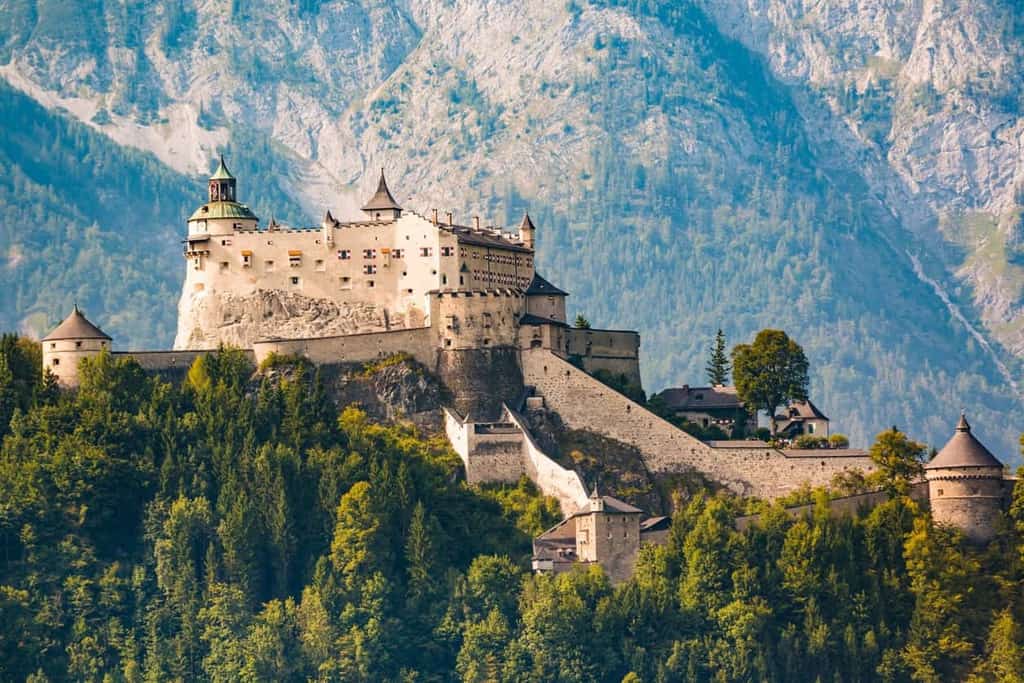Best European Castles to Visit in 2024 and Why (Including a bit of History)
Europe is the land of castles. All throughout the continent, you can visit, drink wine and even spend the night in many of these medieval structures. With over 2,500 hundred alone in Spain, 1000 in the southwestern region of France and a whopping 20,000 rumored to exist in Germany, castle enthusiasts certainly have their work cut out for them.
It’s likely you won’t be able to visit them all, though. So, Winetraveler has narrowed it down to some of the most beautiful castles in Europe you should plan to visit.
If you’re thinking of visiting Europe this year, take a look at some of the current flight deals into the countries we mention below and browse hotel options here.
- Best European Castles to Visit in 2024 and Why (Including a bit of History)
- Château de Chenonceau, France
- Pena Palace, Sintra, Portugal
- Aragonese Castle, Ischia, Italy
- Conwy Castle, Wales
- Bled Castle, Slovenia
- The Alcázar of Segovia, Spain
- Hohenwerfen Castle, Austria
- Buda Castle, Budapest
- Kasteel de Haar, Netherlands
- Dunluce Castle, Northern Ireland
- Neuschwanstein Castle, Germany
- Bran Castle, Romania (Dracula's Castle)
- A Brief History Lesson on "Vlad the Impaler"
- Edinburgh Castle, Scotland
- Prague Castle, Czech Republic
- Kronborg Castle, Denmark
- Frequently Asked Questions about the Best Castles to Visit in Europe
Château de Chenonceau, France
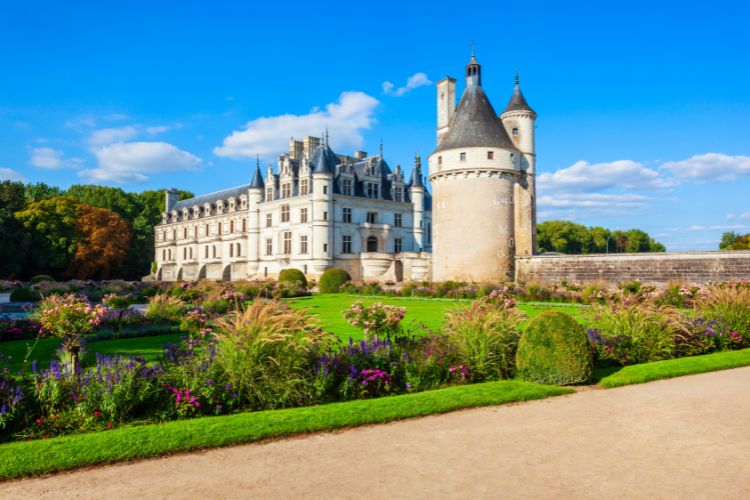
This castle was constructed during the 12th and 13th centuries. Nowadays, only the dungeon remains intact from the original medieval structure. A special bridge section that spans the Cher River was added during reconstruction in the 1500s. The grounds and gardens showcase the charm and beauty of France’s Loire Valley.
As you step into the Château de Chenonceau, you’re stepping into a captivating tale of history, architecture, and natural splendor. The castle, often referred to as the “Ladies’ Château,” owes its elegance and distinctive aesthetic to a series of influential women who owned, expanded, and protected it throughout its history. From the regal arches of Diane de Poitiers’ garden to the flamboyant decoration of Catherine de’ Medici’s grand gallery, you can appreciate the subtle influence of these remarkable women. The interior is equally intriguing, furnished with a rich collection of Renaissance art, tapestries, and antique furniture. Every room holds a story, encapsulating centuries of French history.
Venture outside to the meticulously designed gardens and you’ll understand why the Loire Valley is often referred to as the ‘Garden of France’. A stroll along the formal gardens and through the surrounding woods immerses you in nature’s splendor, with colorful flowers, tranquil water features, and panoramic views over the Cher River.
Due to current demand and an increase in tourism to the region as of 2023, we recommend buying an admission ticket in advance to Château de Chenonceau.
RELATED: The Most Beautiful European Squares to Visit This Year
Pena Palace, Sintra, Portugal
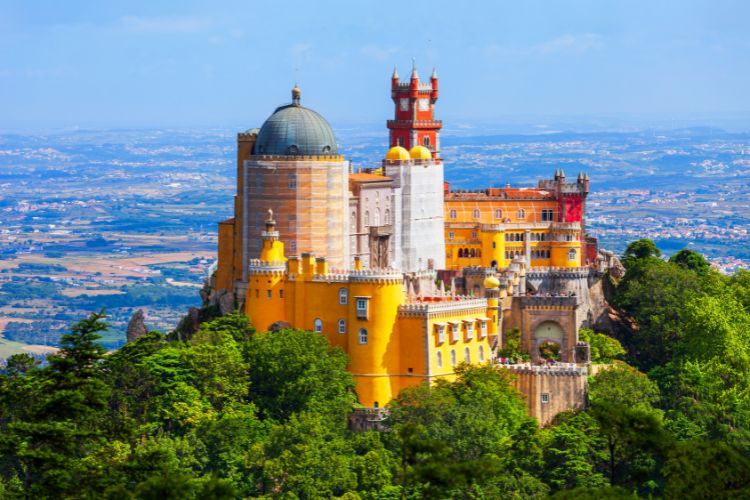
This bold and colorful palace is one of Portugal’s most famous architectural examples of 19th-century Romanticism. Set on a hill and surrounded by a forest, the warm tones of the turrets and towers look especially stunning against the greenery of nature.
RELATED: Best Things to Do in Lisbon This Year (Including Day Trips to Sintra)
As you ascend the hill towards the Palace of Sintra, also known as the Pena Palace, the vibrant hues of its walls — yellows, reds, and blues — pop against the backdrop, as if stepping straight out of a fairy tale. Designed by King Ferdinand II, the palace is a visual feast of Gothic, Manueline, Moorish, and Renaissance elements, reflecting Portugal’s multicultural history.
Inside, each room offers a journey through time, showcasing ornate stuccos, intricate tilework, and period furniture. Don’t miss the breathtaking views from the terraces and ramparts, where you can take in panoramic vistas of the forest-covered hills, the town of Sintra nestled below, and on a clear day, the sparkling Atlantic Ocean in the distance.
The palace is in high demand to visit year-round and cars can lineup with traffic leading up to the entry point, but you can avoid some of the crowds and be guided by a local using this tour that’s ideal for visitors staying in Lisbon and looking to make a day trip to Sintra. It’s especially beneficial as it includes roundtrip transport. So just sit back and relax, be in the moment here.
RECOMMENDED: Go Beyond Lisbon and also Visit Porto, Portugal
Aragonese Castle, Ischia, Italy
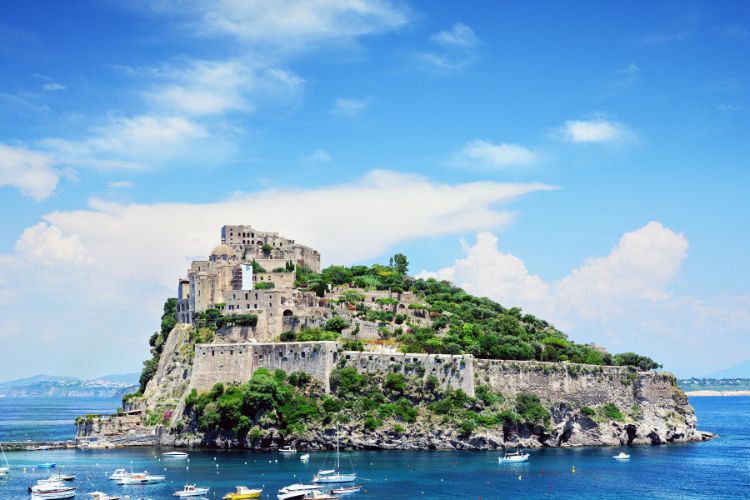
Stepping onto the causeway to the Aragonese Castle, or Castello Aragonese, you’re not just crossing a narrow stretch of sea, but travelling back through millennia of fascinating history. Set atop a volcanic islet off the coast of the enchanting island of Ischia, the castle bears witness to the diverse cultures that have shaped this region since its foundation by the ancient Greeks in 474 BC.
RELATED: Here’s Why Ischia Should be on Your Travel To-Do List This Year
Once a formidable fortress, it became a thriving town during the Middle Ages, filled with convents, churches, and noble residences. Today, its ancient walls echo stories of the Byzantines, Normans, and Aragonese who once sought refuge and domination here. As you explore the cobbled streets, gardens, and fortifications, don’t miss the hauntingly beautiful “Cemetery of the Nuns,” or the frescoed Chapel of Saint Anne.
From its highest ramparts, you’re rewarded with sweeping views of Ischia, the shimmering Tyrrhenian Sea, and the distant peaks of Mount Vesuvius. As the sun sets, painting the sky in soft hues, you’ll understand why this extraordinary place has captivated artists, poets, and dreamers for centuries.
Conwy Castle, Wales
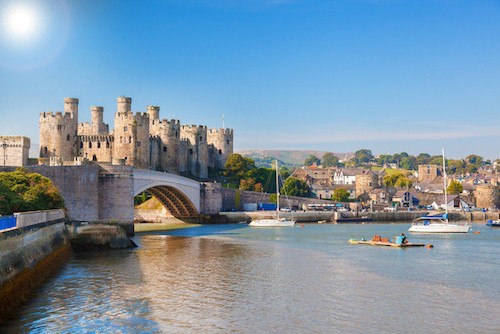
The imposing silhouette of Conwy Castle, with its eight formidable stone towers piercing through the morning fog, is a sight to behold. Perched strategically on a rocky outcrop overlooking the River Conwy in North Wales, this impressive medieval fortress is an embodiment of 13th-century military architecture.
Constructed as part of Edward I’s campaign to subdue the Welsh, the castle was designed by master architect James of St. George. Its layout, complete with an inner and outer ward, is a marvel of medieval military planning. The towers offer breathtaking views of the harbor, the medieval town walls, and the surrounding landscape of Snowdonia.
RELATED: 15 Top Recommended Destinations in the UK to Visit This Year
Exploring Conwy Castle today, you can sense the history that permeates its weathered stones. The Great Hall, once the scene of royal feasts and ceremonies, the King’s Apartments that hosted Edward I himself, and the Chapel where prayers echoed off the stone walls – each corner of the castle tells a tale of the past.
Bled Castle, Slovenia
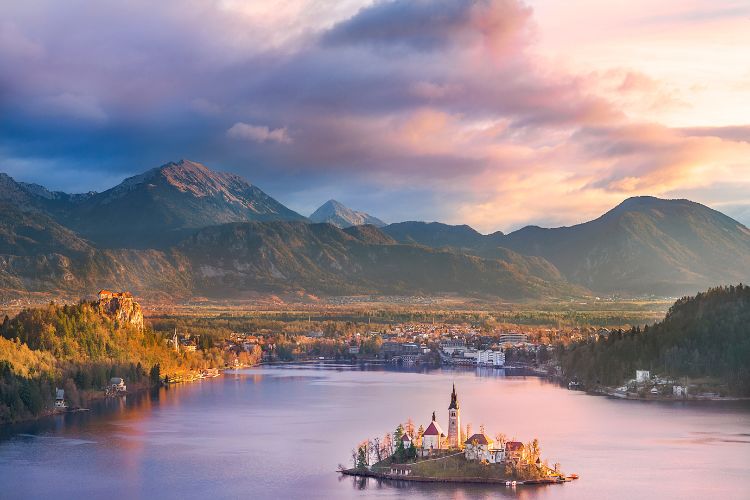
Perched high above the radiant waters of Lake Bled, the Bled Castle, or Blejski Grad, is a majestic spectacle. As one of the oldest castles in Slovenia, it stands as a silent guardian of history, narrating tales of the region that date back over a thousand years. The castle’s strategic location on a steep precipice offers awe-inspiring views of the lake, the charming island with its iconic church, and the surrounding Julian Alps.
RELATED: The Perfect Itinerary for Visiting Bled, Slovenia and Beyond
The castle’s architecture is a fascinating blend of Romanesque, Medieval and Renaissance styles, testament to the different eras it has seen and the changes it has undergone. From the stout defense towers and residential buildings of the medieval period to the newer, elegant Renaissance architecture, the castle tells a visual story of evolving architectural tastes and techniques.
The castle grounds are also home to a moat and a drawbridge, classic elements that add to its medieval charm. Once crossed, these lead to a well-preserved courtyard, around which various parts of the castle are arranged, including a fascinating museum showcasing the historical and cultural journey of the region.
The Alcázar of Segovia, Spain

Though it may evoke images of a fairy tale castle from Disneyland, this particular structure — designed to mimic a ship’s bow — bears a much more complex and riveting history. Dating back to 1120, this well-preserved castle has borne witness to countless transformations reflective of the changing times.
Originally built as a fortress, it played a crucial role in regional power dynamics, serving as a bastion of defense and control. As the centuries passed, its imposing stone walls became the confines of a prison, harboring tales of despair and survival within its stark confines.
In a subsequent era, the castle was repurposed as a military academy. Here, generations of soldiers were trained, their footsteps echoing through the halls that once held knights and prisoners. Each phase of its past imbued the castle with layers of history and a myriad of stories that are etched into the very fabric of its structure.
Today, this fascinating castle serves as a museum, inviting visitors to delve into its rich past. Within its rooms and corridors, you can trace its journey from fortress to prison, from academy to museum, providing a unique lens into the evolving societal and historical contexts.
RECOMMENDED: Staying Madrid? Book a Guided Day Trip to Segovia
Hohenwerfen Castle, Austria
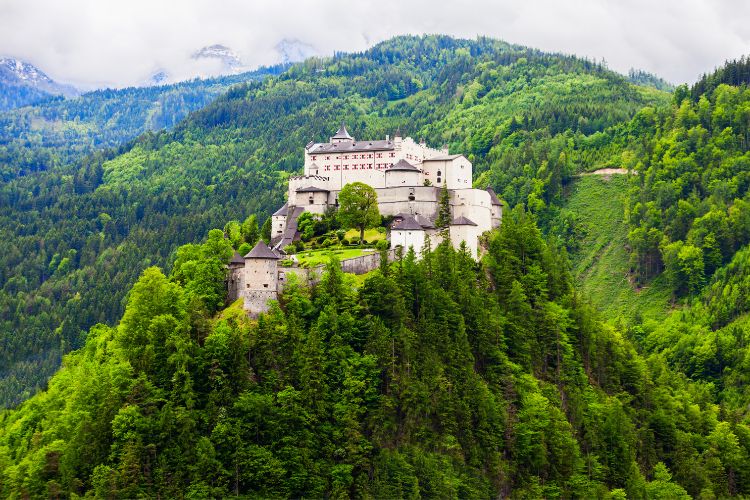
Nestled in the stunning Austrian landscape, the Hohenwerfen Castle stands as a majestic sentinel against the backdrop of the Berchtesgaden Alps. Its strategic location, high on a rocky outcrop over 2,000 feet above the charming town of Werfen in the Salzach Valley, makes it a spectacular sight to behold. Constructed in 1070, this imposing fortress is a perfect example of medieval fortification architecture.
Over the centuries, Hohenwerfen Castle has played diverse roles reflecting the shifting needs and aspirations of its owners and the region it overlooks. As a military base, it stood as a stronghold, guarding the Salzach Valley and acting as a deterrent to potential invaders. Its robust walls, watchtowers, and defensive structures bear testimony to its military past.
RELATED: The Best Things to Do in Hallstatt Austria This Year for History Buffs & Hikers
In times of peace, it transformed into a royal hunting retreat, providing an exclusive sanctuary for the nobility to indulge in their pastimes amidst the castle’s idyllic natural surroundings. The surrounding forested landscapes teem with wildlife, offering a serene backdrop for these pursuits.
Perhaps its most somber role was as a prison. Over the years, its dungeons held various prisoners, their stories echoing in the castle’s darker corners.
Today, Hohenwerfen Castle is open to the public, inviting visitors to explore its history, architecture, and stunning alpine views. Book your entry ticket ahead of time here.
Buda Castle, Budapest
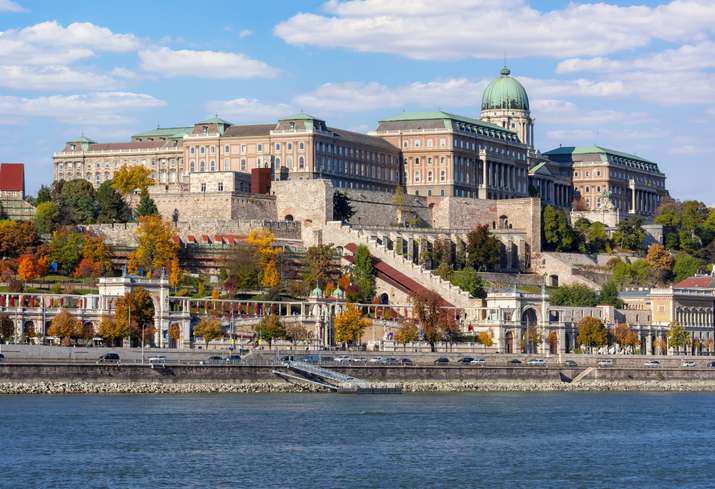
Dominating the skyline of Budapest, Buda Castle, majestically located on Castle Hill, is a remarkable symbol of Hungarian history and culture. Its origins can be traced back to 1265 when the area served as the site for a royal castle and fortified residence for Hungarian kings. Yet, the Buda Castle that we see today owes much of its grandeur to the mid-18th century when a splendid Baroque palace was added to the complex.
This addition marked a significant transformation for Buda Castle, enhancing its architectural appeal and turning it into a royal residence that radiated opulence and grandeur. The palace, with its intricately designed facades, expansive courtyards, and lavish interiors, became the epitome of Baroque architecture in Hungary.
Presently, the Buda Castle complex serves as a cultural hub, housing three significant museums. The Budapest History Museum presents a detailed chronicle of the city’s history from its inception to modern times. The Hungarian National Gallery boasts an impressive collection of Hungarian art, spanning over five centuries. The Museum of Music History provides a fascinating journey into the world of Hungarian and international music.
Alongside these museums, the complex also hosts the National Széchényi Library. This prominent library holds a vast collection of books, manuscripts, and documents, some of which are of significant historical importance, making it a treasure trove for researchers and history buffs.
RELATED: One Week Itinerary For Visiting Budapest: The Best Things to Do
Kasteel de Haar, Netherlands
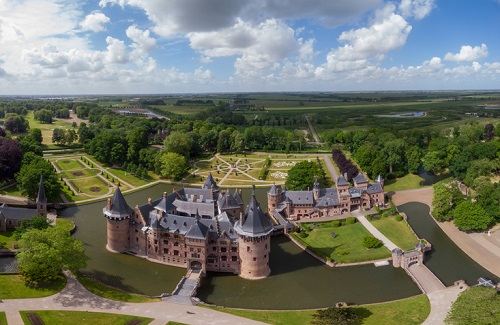
Commanding a prominent position in the Dutch landscape of Utrecht, the De Haar Castle impresses with its grand turrets and magnificent architecture. Though the castle’s origin traces back to the 13th century, it underwent an extensive reconstruction in the late 19th century that brought it back to its prime condition.
The Dutch architect Pierre Cuypers, famous for designing the Rijksmuseum and Amsterdam Central Station, masterminded this restoration. His work ensured that De Haar Castle regained its former glory while reflecting the neo-Gothic architectural style popular in that period. The result is a castle that merges historic authenticity with modern elegance, commanding awe and admiration from all who visit.
The castle’s exterior is a sight to behold, with its richly detailed façades, soaring towers, and decorative roofs. This architectural grandeur extends to an expansive estate of 135 acres, home to beautiful gardens flush with colorful flowers that bloom in various seasons. The park surrounding the castle boasts over 7,000 trees, creating an enchanting landscape that invites leisurely walks and tranquil reflection.
The interior of the castle is equally captivating, filled with intricately detailed woodwork that adds to the charm of the stately rooms. Every corner of the castle whispers stories of the past, from the imposing Main Hall and the elegant Lady’s Boudoir to the more intimate rooms such as the library. Each room brims with exquisite craftsmanship and an impressive collection of art and antiques.
RELATED: Netherlands Visitor’s Guide: Best Things to Do This Year
Dunluce Castle, Northern Ireland
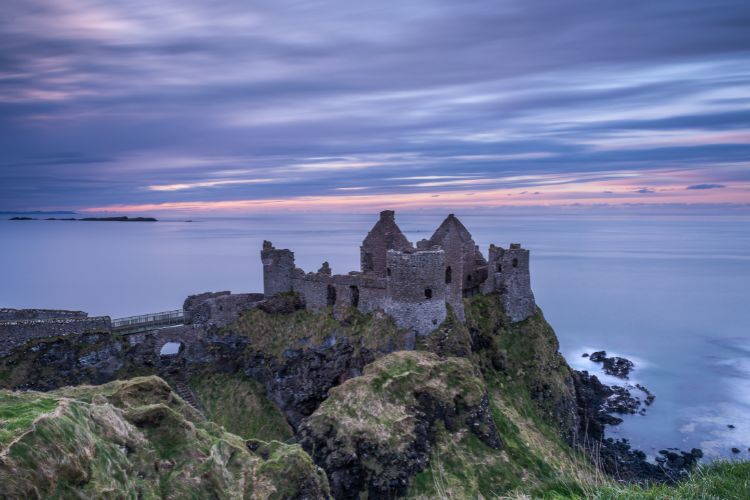
Despite being in ruins, Dunluce Castle in Northern Ireland possesses an enigmatic allure that captivates all who visit. Perched precariously on a rocky cliff over the turbulent North Atlantic waves, its crumbling silhouette lends a sense of poignant beauty and intrigue.
The castle’s origins can be traced back to the 13th century, with its history fraught with dramatic events, including clan feuds, invasions, and even tales of a portion of the kitchen collapsing into the sea. Over centuries, the ceaseless sea winds and rains have weathered its walls, and today, its skeletal stone remains stand testament to its enduring resilience.
But far from diminishing its appeal, the ruinous state of Dunluce Castle enhances its charm, lending it an air of mystery and nostalgia. As you navigate through the remains of the grand hall, towers, and living quarters, you can almost hear the echoes of the past reverberating through the desolate stone walls.
Equally impressive is the castle’s natural surroundings. Its cliff-top position offers breathtaking views of the wild North Atlantic and the rugged Irish coastline. On a stormy day, the sight of crashing waves against the cliff base makes a truly dramatic spectacle, while on calmer days, the tranquil sea views impart a sense of peaceful serenity.
RELATED: Here’s How to Spend 4 Romantic Days in Ireland
Neuschwanstein Castle, Germany
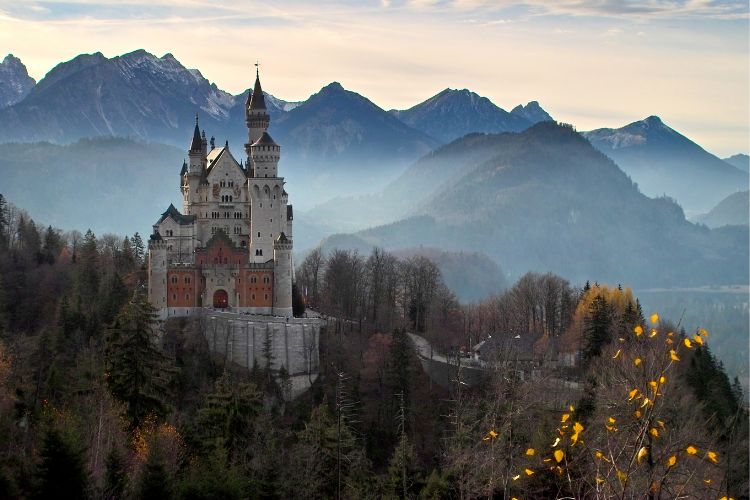
Neuschwanstein Castle, high in the lush green mountains of Bavaria, is undoubtedly one of the most renowned castles globally. Constructed in the late 19th century, it was designed as a personal refuge for the reclusive King Ludwig II of Bavaria, reflecting his love for romantic medieval legends and his fascination with the operatic works of Richard Wagner.
RECOMMENDED: Take a Day Trip from Munich to Explore Neuschwanstein Castle
Adorned with soaring turrets and opulent interiors, the castle was Ludwig’s vision of a perfect fairy-tale palace. It was, however, far from being a mere whimsical retreat. The castle boasts technological innovations well ahead of its time, such as central heating, automatic flush toilets, and an ingenious kitchen design that allowed for efficient meal preparation and delivery to the royal dining room.
Drawing over a million visitors each year, Neuschwanstein has made an indelible impact on popular culture. Walt Disney himself was so enchanted by its fairy-tale beauty that he used it as the official inspiration for Sleeping Beauty’s castle at Disneyland, a decision that further heightened the castle’s worldwide fame.
Beyond the realm of theme parks, Neuschwanstein has also graced the silver screen in a number of films, its majestic silhouette and stunning surroundings providing an ideal setting for stories of romance and adventure.
Bran Castle, Romania (Dracula’s Castle)
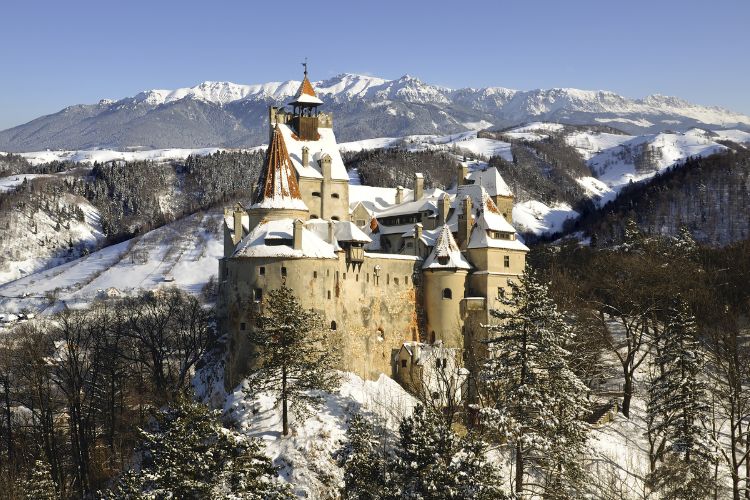
Bran Castle, in the Carpathian Mountains of Romania, is steeped in history and mystery. Often referred to as ‘Dracula’s Castle,’ its gothic structure and links to the infamous Vlad the Impaler give it an eerie allure that resonates with fans of the supernatural, even though its real connection to Bram Stoker’s novel “Dracula” is tenuous at best.
The castle’s story begins in 1211 when the Teutonic Knights erected it as a stronghold against the invading Ottomans. Centuries later, it fell into the hands of the Saxons, who fortified it further to serve as a customs post on the mountain pass between Transylvania and Wallachia. The castle was then bestowed upon Queen Marie of Romania in the early 20th century, becoming her cherished retreat. Queen Marie initiated a series of renovations that embellished the castle with her unique style, blending its austere military architecture with the comfort and elegance of a royal residence.
Today, Bran Castle is privately owned, and its historic rooms and corridors have been converted into a fascinating museum. Here, visitors can explore a rich collection of furniture, art, and artifacts from its royal era, providing a glimpse into Queen Marie’s life and reign. The castle also exhibits information about local customs and the legends of vampires, acknowledging its pop culture identity as ‘Dracula’s Castle.’
You can watch a teaser of the Mehmed vs. Vlad Dracula docudrama below:

Edinburgh Castle, Scotland
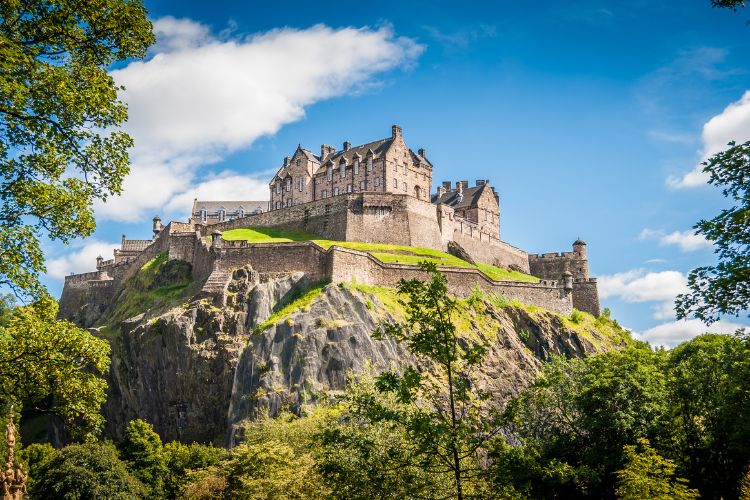
Edinburgh Castle, a mighty fortress sitting atop Castle Rock in the heart of Scotland’s capital, isn’t just a historic site – it’s a cornerstone of the country’s rich history. This royal castle offers not just stunning views over the cityscape, but a deep dive into Scotland’s past that’s sure to captivate any visitor.
The castle’s history stretches back to the Iron Age, but its most dramatic chapters unfold during the Middle Ages and Early Modern Period. It was the center stage for Scotland’s complex relations with England, witnessing many conflicts including the Wars of Scottish Independence in the 13th and 14th centuries. William Wallace, the legendary freedom fighter, and Robert the Bruce, King of Scots, both played crucial roles in these wars.
Exploring the castle’s ancient walls and structures, you can immerse yourself in these turbulent times. St Margaret’s Chapel, the oldest surviving building in Edinburgh, stands within the castle grounds, a testament to a thousand years of history. Then there’s the Great Hall, with its majestic hammerbeam roof, and the Royal Palace, housing the Honours of Scotland – the country’s Crown Jewels.
The castle’s proximity to key historical sites, like the battlefield of Bannockburn and Stirling Castle, enhances its significance. These nearby sites were integral to William Wallace’s and Robert the Bruce’s struggles for Scottish independence, and visiting them can help complete the picture of Scotland’s heroic past.
Edinburgh Castle isn’t just about history, though. With its high vantage point on the extinct volcanic Castle Rock, it offers breathtaking views of the city and beyond, stretching out to the Firth of Forth. Also within its precincts are several shops, restaurants, and museums such as the National War Museum of Scotland. The castle even houses the famous One O’Clock Gun, a time signal that fires daily and is sure to startle unwary tourists!
Prague Castle, Czech Republic
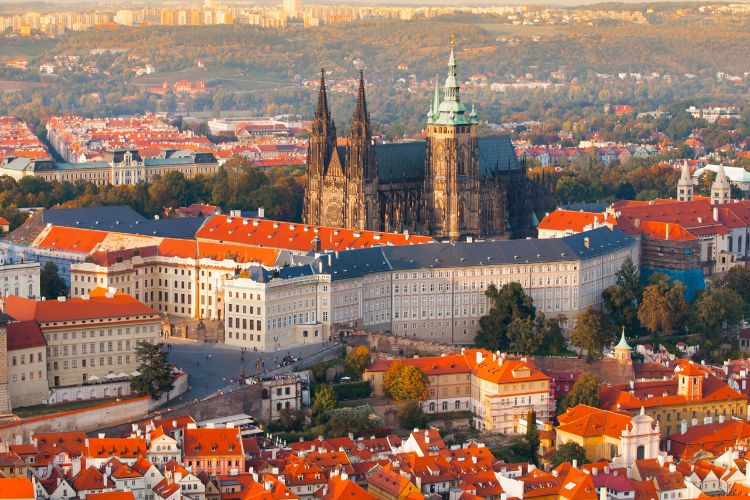
Occupying a staggering 750,000 square feet, the 9th-century royal structure known as Prague Castle holds the title of the largest ancient castle in the world according to the Guinness Book of World Records. Set high on a hill overlooking the city’s enchanting Old Town, this castle complex is a testament to the rich history of the Czech Republic and its people.
RECOMMENDED: Buy Your Prague Castle Skip-the-Line Ticket Online While They’re Available
The expansive area of Prague Castle encompasses a variety of historical and architectural wonders. The castle is home to the Gothic masterpiece St. Vitus Cathedral, which took nearly 600 years to complete and is the final resting place of many Bohemian kings and Holy Roman Emperors. Its stunning stained glass windows and the panoramic view of the city from the top of the main tower make it a must-visit.
Other highlights include the Old Royal Palace, with its massive Vladislav Hall, a grand room used for banquets, coronations, and even jousting tournaments in bygone eras. The Basilica of St. George, the oldest surviving church building within the castle complex, offers a glimpse into Romanesque architecture.
The castle complex also houses several intriguing museums, including the National Gallery collection of Bohemian baroque and mannerism art, the Prague Castle Picture Gallery, the Museum of Military History, and the Toy Museum, which holds an impressive collection of toys from all over the world.
Adding to its allure are the beautifully manicured Royal Garden and South Gardens, as well as the picturesque Golden Lane. This historic street, lined with colorful tiny houses, once housed goldsmiths, castle guards, and even the famed writer Franz Kafka.
The Strahov Monastery, located near the castle, adds another layer of history with its stunning library and a brewery that has been making beer since the 14th century.
RELATED: 4 Days in Prague: Itinerary for Food & Wine Lovers
Kronborg Castle, Denmark
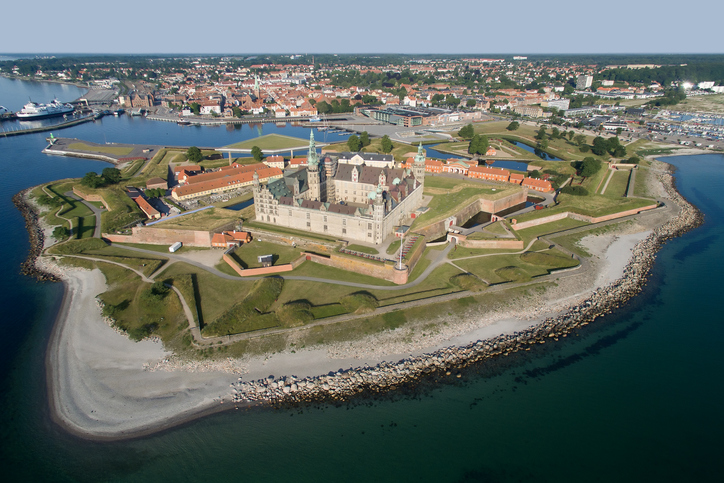
Kronborg Castle, proudly standing in Denmark, holds a prominent place in both global literature and European history. Known as Hamlet’s Castle, it is immortalized as Elsinore, the setting of Shakespeare’s renowned tragedy, Hamlet. The play’s vivid descriptions are believed to have been inspired by the castle’s imposing structure and strategic location, allowing Shakespeare to never set foot in Denmark but yet recreate this mighty fortress with uncanny accuracy.
Founded in the 1420s, Kronborg Castle was initially a fortress intended to enforce collection of sound dues, a tax levied by the Danish King on all ships passing through the narrow strait of the Sound, the gateway to the Baltic Sea. Its strategic position thus played a pivotal role in controlling naval traffic and securing the kingdom’s prosperity.
In 1629, a devastating fire engulfed Kronborg Castle, causing significant damage. However, the misfortune provided an opportunity for a grand makeover. King Christian IV, renowned for his architectural projects, spearheaded the castle’s reconstruction, transforming it into an elaborate Baroque residence while retaining its fortified structure.
Visitors today can explore the royal apartments, adorned with intricate woodwork and lavishly decorated interiors that reflect the wealth and power of Danish monarchs. The castle also houses the Maritime Museum, offering insights into Denmark’s maritime history and the significance of the Sound dues.
But the allure of Kronborg Castle extends underground too. The casemates, a network of dark, eerie passages and chambers underneath the castle, are home to the legendary figure of Holger Danske. According to the myth, this ancient Danish hero is said to be sleeping there, ready to awaken and defend Denmark in the time of its greatest need.
Frequently Asked Questions about the Best Castles to Visit in Europe
You are reading “The Most Beautiful Castles in Europe to Visit” Back To Top
castles near me, castles in Europe to visit near me, most beautiful castles to visit in Europe: top travel destinations to visit this year
If you enjoyed this guide, make sure you register to become a Winetraveler for free! You’ll get access to all of our content and interact with other Winetravelers and for travel inspiration around the world. Be sure to follow along with us on Twitter and Instagram as we continue to feature more exciting destinations.
